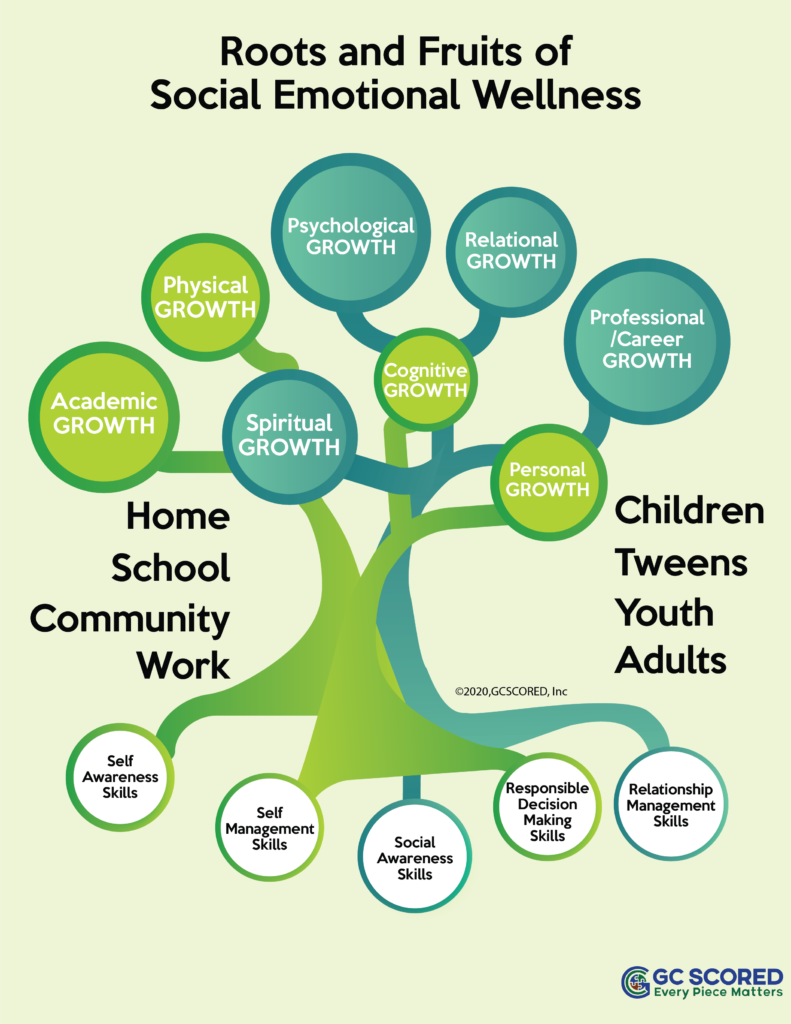Cultivating SEEDS System (CSS)
Social-emotional learning research and practice have gained prominence in academic settings worldwide. However, communities of color, marginalized, and under-resourced groups are often excluded from research designs, curriculum development, and implementation. Consequently, the lived experiences of their students, educators, administrators, and families are not considered in curriculum design and instruction.
The CSS Framework® addresses this gap by centering communities of color in its research, design, curriculum, and implementation. This inclusive approach ensures that communities of color are no longer on the periphery of mental health education, relationship cultivation skills training, coaching, and emotional wellness support services. The CSS Framework® is designed with you in mind.
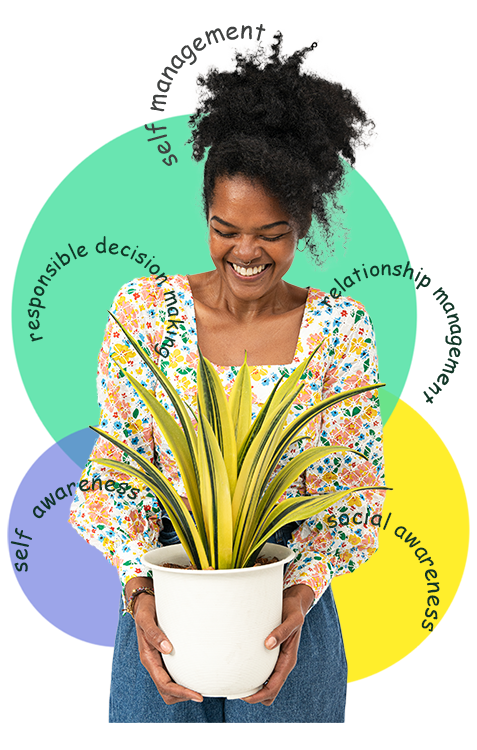
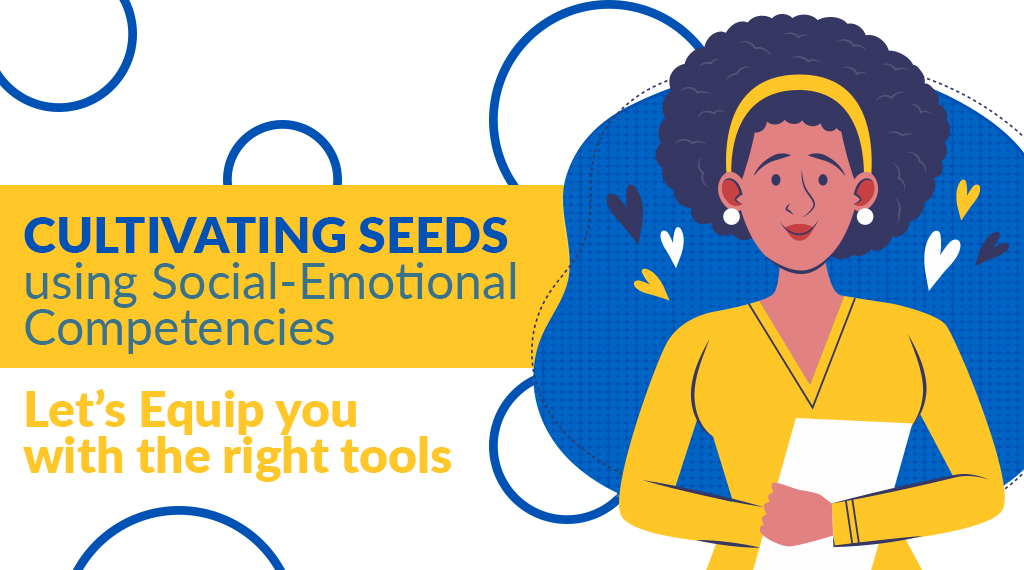
Social-emotional learning research and practice have gained prominence in academic settings worldwide. However, communities of color, marginalized, and under-resourced groups are often excluded from research designs, curriculum development, and implementation. Consequently, the lived experiences of their students, educators, administrators, and families are not considered in curriculum design and instruction..
The CSS Framework® addresses this gap by centering communities of color in its research, design, curriculum, and implementation. This inclusive approach ensures that communities of color are no longer on the periphery of mental health education, relationship cultivation skills training, coaching, and emotional wellness support services. The CSS Framework® is designed with you in mind.
The research and practice regarding social-emotional learning has increasingly taken center stage in academic settings across the USA and the world. As with many curriculum and programming best practices, communities of color, marginalized, invisible, voiceless communities,under-resourced schools and communities are often excluded in the research designs and curriculum development and implementation.Therefore, these communities and the lived experiences of their students, educators, administrators, families and other school stakeholders are excluded from curriculum design, implementation and instruction.
The Components Of The Css Framework®
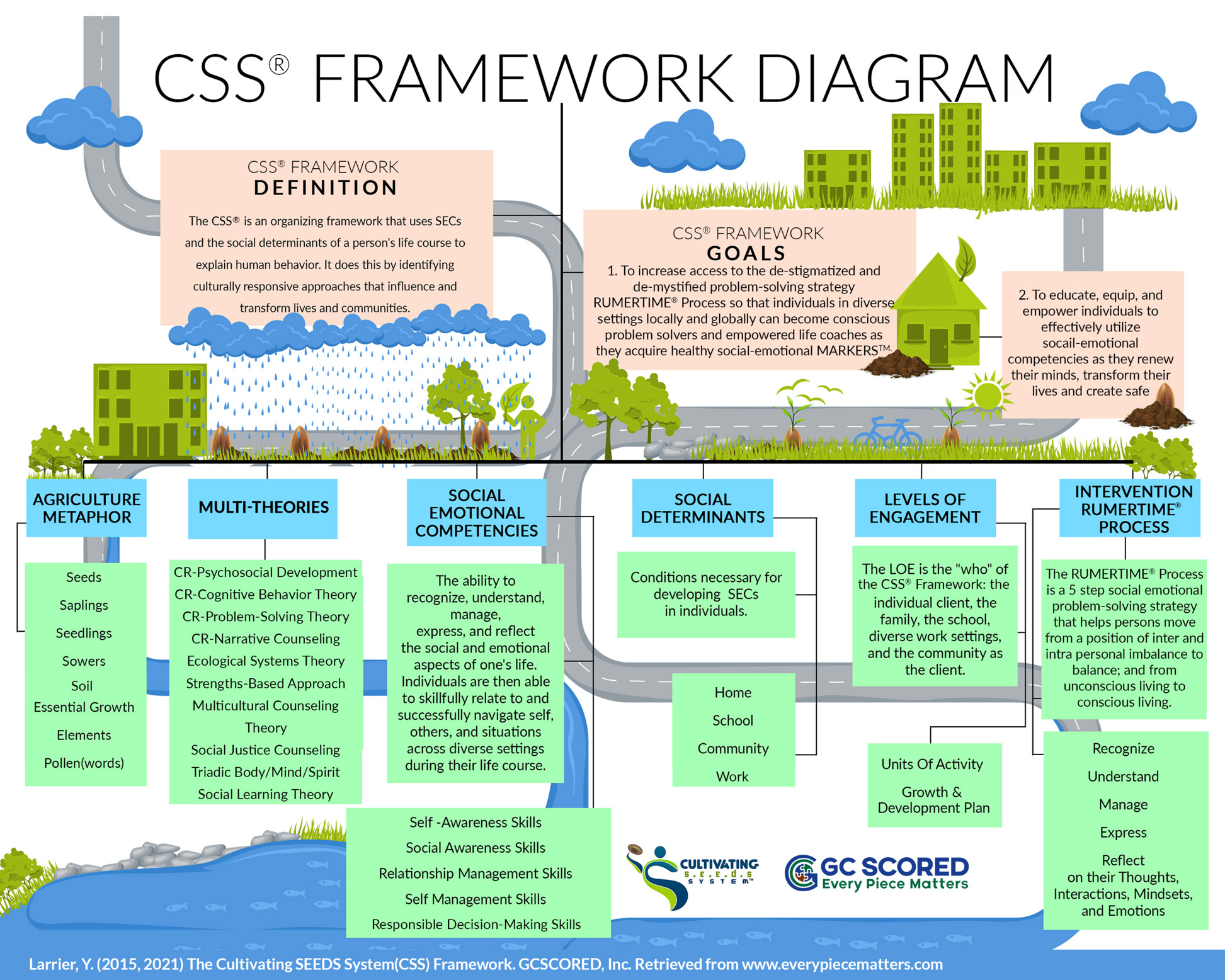
The CSS Framework® curricula’s foundational components are in alignment with, and exceeds the guidelines set forth by CASEL and the EASEL Lab at Harvard University, that school districts should consider when making decisions about which social emotional learning curricula is best for their school community:
- Multi-theories(Research and evidenced based)
- Social-emotional competencies(“as air is to life, so are social emotional competencies to relationships, they are like the air we breathe.” Yvonne Larrier)
- Social determinants( culturally responsive, historical and contemporary contextual and ecological considerations)
- Triadic principles of wellness (body/mind/spirit)(holistic/multidimensional approach to supporting and seeing students, educators, families, etc.)
- Levels of engagement( all stakeholders must be fully engaged in order for individual,familial, educational, organizational and community wholeness to be attained. Yvonne Larrier)
- RUMERTIME Process® (the prevention/intervention five step,social-emotional problem-solving strategy)
- Units of Activity(culturally responsive, multimodal teaching and learning interactive, engaging and inclusive processes, activities,games and strategies)
Each component works synergistically to create what we use as a re-conceptualized, culturally responsive approach to true holistic education.
The CSS Framework® curricula’s foundational components are in alignment with, and exceeds the guidelines set forth by CASEL and the EASEL Lab at Harvard University, that school districts should consider when making decisions about which social emotional learning curricula is best for their school community:
- Multi-theories(Research and evidenced based)
- Social-emotional competencies(“as air is to life, so are social emotional competencies to relationships, they are like the air we breathe.” Yvonne Larrier)
- Social determinants( culturally responsive, historical and contemporary contextual and ecological considerations)
- Triadic principles of wellness (body/mind/spirit)(holistic/multidimensional approach to supporting and seeing students, educators, families, etc.)
- Levels of engagement( all stakeholders must be fully engaged in order for individual,familial, educational, organizational and community wholeness to be attained. Yvonne Larrier)
- RUMERTIME Process® (the prevention/intervention five step,social-emotional problem-solving strategy)
- Units of Activity(culturally responsive, multimodal teaching and learning interactive, engaging and inclusive processes, activities,games and strategies)
Each component works synergistically to create what we use as a re-conceptualized, culturally responsive approach to true holistic education.
What is the Cultivating SEEDS System Framework®?
CSS® is an organizing framework that gives context, order and meaning to information obtained about a client’s background. It is a multi-theoretical framework that uses social emotional competencies and the social determinants of a person’s life course to explain (why, what, and root) human behavior. It also identifies the culturally responsive approach-the RUMERTIME Process® to educate, equip and empower individuals as they renew their minds, transform lives and create safer communities. CSS® stands for the Cultivating SEEDS System®. In turn, SEEDS is an acronym that stands for Social Emotional Education in Diverse Settings.
CSS FRAMEWORK®
To increase access to the five-step, culturally responsive, de-stigmatized and de-mystified problem-solving RUMERTIME Process® so that individuals in diverse settings locally and globally can become conscious problem solvers and empowered life coaches as they acquire healthy social-emotional Mindsets, Activities/Ambitions, Relationships, Knowledge, Emotions, Resources, Strategies (MARKERS®).
To engage, educate, equip, and empower individuals to effectively utilize relationship cultivation skills as they renew their minds, transform their lives and create safer communities.
GOAL ONE
To increase access to the culturally responsive, de-stigmatized and de-mystified problem-solving RUMERTIME Process® so that individuals in diverse settings locally and globally can become conscious problem solvers and empowered life coaches as they acquire healthy social-emotional Mindsets, Activities/Ambitions, Relationships, Knowledge, Emotions, Resources, Skills/Strategies (MARKERS™).
GOAL TWO
To educate, equip, and empower individuals to effectively utilize social-emotional competencies as they renew their minds, transform their lives and create safer communities.

CSS Framework FEATURES OF THE CSS FRAMEWORK®
Agriculture is a universal, unbiased construct, and everywhere across the globe elements of the natural plant world exist.
The CSS Framework® uses agricultural metaphors to teach, demystify, de-stigmatize, and re-conceptualize mental health concepts as they relate to the inevitable life challenges associated with self, others, and situations, both locally and globally.
Students have shown positive statistically significant changes in their emotional state after engaging in the CSS Framework®. Teachers, administrators, parents, and others have reported improvement in the academic performances, prosocial behaviors, and attendance of students engaging in the CSS®.
Facilitators teaching the CSS® are not required to have a formal college education. Many of the activities included in the CSS® offer the facilitator the opportunity to use materials indigenous to their culture and setting. However, facilitators need to complete official CSS Framework® courses.
Concepts in the CSS® are developmentally appropriate and strongly linked to the plant world, making the concepts both practical, non-biased, and easy to learn.
The CSS® is accessible, generalizable, and flexible. It was designed to be easily modified to fit diverse settings, needs, ethnocultural groups, time, ages, and resource levels.
Facilitators teaching the CSS® can have diverse levels of educational attainment as well as a wide range of life experiences.
The ecological systems theory, CR-CBT, multicultural counseling theory, social justice counseling, and narrative therapy are several of the theories that ground the CSS Framework®. This grounding ensures that rudimentary components including voice, beliefs, culture, and experiences are reflected in the learning and teaching of the CSS Framework®.
The activities included in the lessons actively engage multiple intelligences. Furthermore, the active learning lessons are delivered in multiple modalities, such as individual, small group, large group, classroom, workshop, advisory and circles.
The mulching activities in the CSS® cover ages 3-103, and all learning abilities and styles. The CSS® includes activities for multiple types of facilitators and settings.
The CSS Framework® because of its scalability feature lends itself to being utilized by a wide range of individuals with varying ability and training levels. Therefore,the RUMERTIME Process® which is the prevention/intervention strategy embedded within the framework is a viable task shifting and sharing strategy that utilizes community members to be trained as laypersons in the social-emotional wellness support movement.
The CSS Framework® is thoughtfully designed to be easily integrated into diverse settings, such as homes, schools, higher education institutions, religious organizations, businesses, community organizations, etc.
About the RUMERTIME Process®
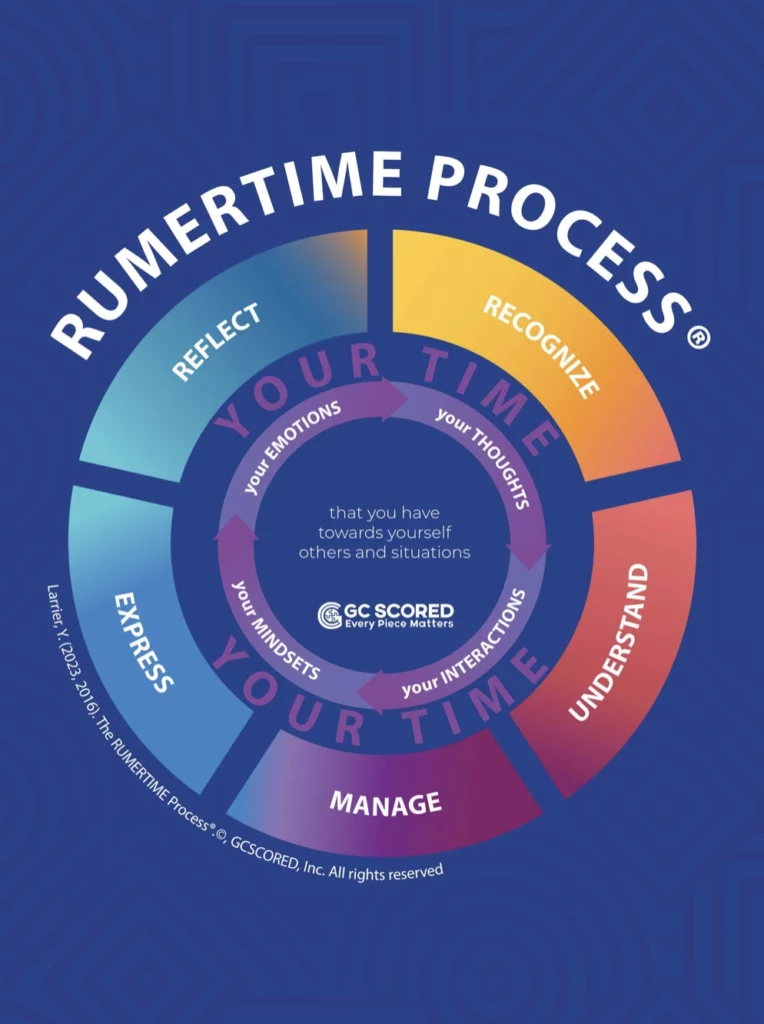
How does the RUMERTIME Process® fit into the CSS Framework®?
The RUMERTIME Process® is the prevention/intervention component of the CSS Framework®. It is the vehicle that transports the elements of the framework to all stakeholders.
What is the RUMERTIME Process®?
The RUMERTIME Process® is a culturally responsive five-step social-emotional, problem-solving strategy
that supports individuals in their journey from a position of intra- and interpersonal imbalance to a position of intra- and interpersonal balance and from unconscious living to conscious living.
The Goals of the RUMERTIME Process®
Goal 1
To provide individuals with a simple, five-step, culturally responsive, relationship cultivating, problem-solving strategy for addressing life’s challenges they experience within themselves, with others, and across a variety of situations and settings.
Goal 2
To engage, educate, equip, and empower individuals to effectively utilize the problem-solving strategy in their daily interactions. The impact is felt proximally and distally as children, youth, and adults in their homes, schools, workplaces and communities become socially emotionally competent.
Goal 1
To provide individuals with a simple, culturally responsive, five-step social-emotional, problem-solving strategy for addressing life’s challenges they experience within themselves, with others, and across a variety of situations and settings.
Goal 2
To educate, equip and empower individuals to effectively utilize the problem-solving strategy in their daily interactions. The impact is felt proximally and distally as children, youth, and adults in their homes, schools, workplaces and communities become socially emotionally competent.
RUMERIZING®
Rumerizing is a powerful tool that individuals can utilize at any point in their lives and for a multitude of life events. It encourages conscious living, mindfulness, and emotional presence, not only in times of struggle but also in moments of joy. While often initiated in response to a triggering event that sparks negative thoughts, actions, beliefs, and feelings, Rumerizing can be applied universally. By Recognizing, Understanding, Managing, Expressing, and Reflecting on Thoughts, Interactions, Mindsets, and Emotions, individuals can actively disrupt negative patterns and foster a more positive and conscious experience of life.
RUMURIZING®
Individuals can rumerize 24/7/365 for all types of life events. However, in the initial stages of incorporating this process into one’s gardening tool bag, people tend to rumerize more when a triggering event occurs in their life and activates negative thinking, acting and feeling patterns. They interrupt this pattern of negativity as they: Recognize, Understand, Manage, Express and Reflect on their Thoughts, Interactions, Mindsets and Emotions while they relate to the triggering event.
Evidence of Effectiveness
GCSCORED has conducted several studies with diverse stakeholder groups as it relates to cultural diversity, age, geographical location, and roles. Contact us for more information on our results.
